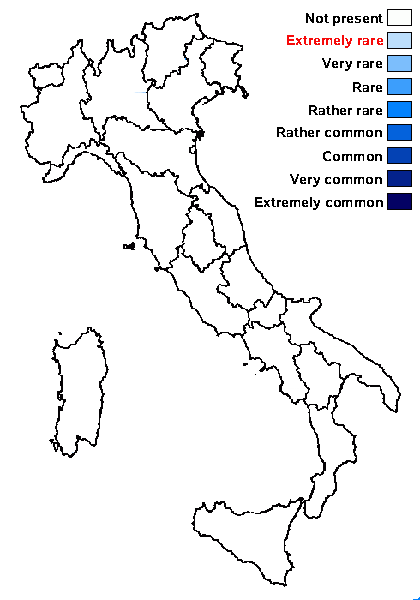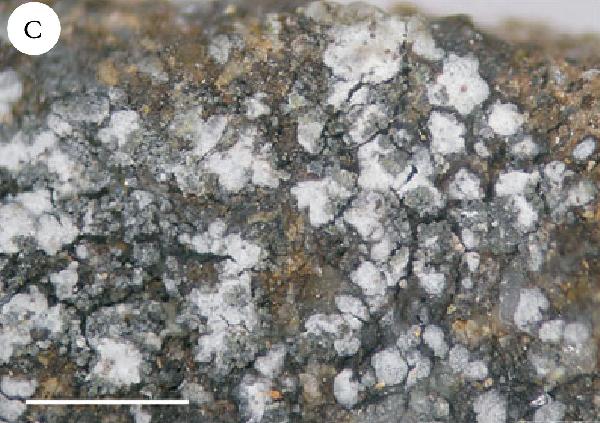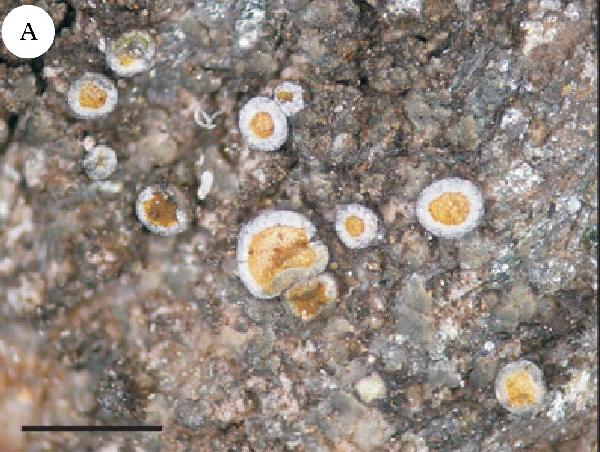Caloplaca subalpina Vondrák, Šoun & Palice
in Vondrák & al., Lichenologist, 40: 378, 2008.
Synonyms:
Distribution:
Description: Thallus crustose, episubstratic, areolate, the areoles flat to convex, merging into squamules at thallus margins, sorediate, grey or rarely dark green, usually white-pruinose in spots or over most of the surface. Soralia dark grey, at first developing from the margins of the areoles, sometimes spreading over the whole surface, the soredia strongly K+ violet in section, 22-38 µm in diam. Epinecral layer up to c. 15 µm thick; cortex conspicuous, (5-)17-11(-53) µm thick, colourless in lower part, sordid-grey (K+ violet in section) in upper part, formed of a tight paraplectenchymatous tissue of large isodiametrical cells; medulla, formed by a loose prosoplectenchymatous tissue of thin-walled hyphae. Apothecia usually not abundant, lecanorine, 0.35-0.6 mm across, almost always white-pruinose, but mainly growing on the non-pruinose part of thallus, with an orange disc and a grey, raised, persistent thalline margin. Cortex in lower part of thalline exciple up to 70 µm thick; proper exciple up to 40 µm thick, prosoplectenchymatous, formed of thin-walled, c. 2-4 µm thick hyphae; epithecium orange, granulose, K+ purple-red; hymenium colourless, 60-80 µm high; paraphyses sparingly branched and anastomosing, 1.5-2 µm thick at mid-level, the apical cells up to 5 µm wide; hypothecium colourless. Asci 8-spored, clavate, functionally unitunicate, apically thickened with a broad internal beak, the inner part of apex and external cap I+ blue, Teloschistes-type. Ascospores 2-celled, polarilocular, ellipsoid, 9-12(-15) x 4.5-7 µm, the equatorial tyhickening (“septum”) 3-5.5 µm, c. 1/3 of spore length. Conidia mostly acrogenous, bacilliform, 2-5 x 0.5-1.5 µm. Photobiont chlorococcoid. Spot tests: thallus K+ violet (most evident in sections under the microscope), C+ weakly violet, KC-, P-. Apothecial disc K+ purple-red. Chemistry: thallus with the Sedifolia-grey pigment; apothecial disc (epithecium) with parietin (major), teloschistin, fallacinal, parietinic acid and emodin (minor or traces).Note: a recently-described species growing on base-rich schists and conglomerate outcrops in glacial cirques of the subalpine vegetation belt, mostly on vertical, sheltered, but well-lit rocks beneath overhangs. It is known from the Alps (Austria), the Pyrenees (Spain) and the Sudetes. To be looked for in the Italian Alps.
Growth form: Crustose
Substrata: rocks
Photobiont: green algae other than Trentepohlia
Reproductive strategy: mainly asexual, by soredia, or soredia-like structures (e.g. blastidia)
In underhangs rarely wetted by rain

Predictive model

Source: Vondrák & al. 2008. Caloplaca subalpina and C. thracopontica, two new saxicolous species from the Caloplaca cerina group (Teloschistales). Lichenologist, 40, 5: 375-386.
A, apothecia (CBFS JV6071); B, sublobate marginal parts of thallus (CBFS JV6071); C, thallus with soralia (isotype) Scale: 1 mm

Source: Vondrák & al. 2008. Caloplaca subalpina and C. thracopontica, two new saxicolous species from the Caloplaca cerina group (Teloschistales). Lichenologist, 40, 5: 375-386.
A, apothecia (CBFS JV6071); B, sublobate marginal parts of thallus (CBFS JV6071); C, thallus with soralia (isotype) Scale: 1 mm

Source: Vondrák & al. 2008. Caloplaca subalpina and C. thracopontica, two new saxicolous species from the Caloplaca cerina group (Teloschistales). Lichenologist, 40, 5: 375-386.
A, apothecia (CBFS JV6071); B, sublobate marginal parts of thallus (CBFS JV6071); C, thallus with soralia (isotype) Scale: 1 mm
Growth form: Crustose
Substrata: rocks
Photobiont: green algae other than Trentepohlia
Reproductive strategy: mainly asexual, by soredia, or soredia-like structures (e.g. blastidia)
In underhangs rarely wetted by rain

Predictive model

Source: Vondrák & al. 2008. Caloplaca subalpina and C. thracopontica, two new saxicolous species from the Caloplaca cerina group (Teloschistales). Lichenologist, 40, 5: 375-386.
A, apothecia (CBFS JV6071); B, sublobate marginal parts of thallus (CBFS JV6071); C, thallus with soralia (isotype) Scale: 1 mm

Source: Vondrák & al. 2008. Caloplaca subalpina and C. thracopontica, two new saxicolous species from the Caloplaca cerina group (Teloschistales). Lichenologist, 40, 5: 375-386.
A, apothecia (CBFS JV6071); B, sublobate marginal parts of thallus (CBFS JV6071); C, thallus with soralia (isotype) Scale: 1 mm


